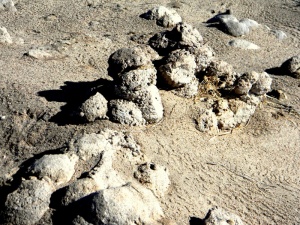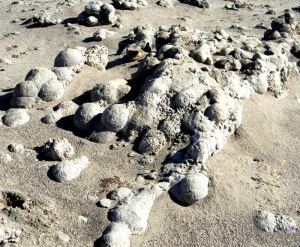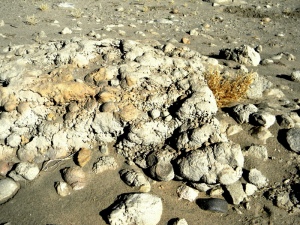WHAT GOES AROUND CAN BECOME A ROUND
Rocks are one of my passions, right up there with root beer floats and, attesting to my age, Daisy Duke shorts. Sometimes it is not the rock type that is interesting, but the shape of the rock. It seems that the most common question I am asked is, “What made this rock so round?” In the studies of geology and sedimentology one encounters many unusual, yet natural shapes. Recently someone asked what the rock balls just up from the lakeshore are. Now, that is an interesting question.
Look at the formation of rock ‘balls’ below. What are they? How were they made?
These funny looking sort of un-rocks are called nodules or concretions and are generally a combination of two components, a solid center mass  and an encrusting outer material. They are sort of like an old Tootsie Pop. The Pop, however, was hard on the outside and chewy in the middle. These are the opposite. Chew the center of a nodule and you will be gumming everything else for some time. It is usually made of manganese, cobalt or some other very hard metal. I am sure some of the young people immediately thought ‘oh yeah, like Metallica.’ No, that is Heavy Metal. Not like gold, but they do have a Gold Record. And now that some of the old people are completely confused, let us return to nodules.
and an encrusting outer material. They are sort of like an old Tootsie Pop. The Pop, however, was hard on the outside and chewy in the middle. These are the opposite. Chew the center of a nodule and you will be gumming everything else for some time. It is usually made of manganese, cobalt or some other very hard metal. I am sure some of the young people immediately thought ‘oh yeah, like Metallica.’ No, that is Heavy Metal. Not like gold, but they do have a Gold Record. And now that some of the old people are completely confused, let us return to nodules.
What is interesting about them here is that they usually occur on the seafloor and we are hundreds of miles from the closest ocean. Just recently a German research ship, the R/V Sonne, while cruising a few hundred miles east of Barbados discovered a seafloor littered with manganese nodules ranging from soft ball to bowling ball size. Mine are not quite that big, only about baseball size, but they are very nice balls none-the-less.
Manganese nodules have been found in every ocean, though most occur in the Pacific. Exactly how they are formed is still a mystery, but excess metals reacting in sea water or close to underwater hydrothermal vents, maybe with the help of microbes, is the most possible method.
At times when scientists cannot explain an occurrence with certainty they use the SWAG method, a Scientific Wild-ass Guess.
The chemistry of nodules, however, is well-known, but I will not bore you with that aspect, though I find it extremely fascinating, and it could be considered rather complex. Unraveling a nodule is a little like peeling an onion that has lain around for several million years while surface material is continually added in semi-liquid or viscous form, adheres and hardens. The real rub, so to speak, is that one cannot know what is encased within the ball until it is opened or viewed with remote sensing equipment.
Imagine walking down the street and you see a man coming toward you. What can you tell about him? From a distance all you can see is his clothing. What does that tell you about what is inside? Usually very little unless he is not wearing clothes, at which time I suggest running. As he gets closer you can see the clothing more distinctly, his face, skin and maybe a hat. Closer still and imperfections in the skin become visible; the condition of the clothing and how well it fits is obvious. You still cannot tell exactly what is inside, but you can make an educated guess. That is also how a geologist looks at a rock. There are textures and colors, weight and hardness, general shape and condition that can reveal much.
And no, that does not answer the question of how they got here in the southwestern desert of North America. To uncover the answer we must go back in time. In Jules Verne’s “The Time Machine” a man goes through time finding all sorts of wonderful things including pretty women. All we are looking for are rocks. They are rocks that form under water, so when was New Mexico covered with sea water?
There is a geologic model explaining this called transgressive/regressive seas. It describes how ocean water transgresses, or covers the land and then regresses, or retreats back into the ocean basin. A surfer would love transgression; a real estate agent would love regression. So when did this happen? First we have to go back a ways. Do not start looking for last year’s calendar; we are going back 450 million years to the Ordovician Period. Then, in the Silurian Period about 420 million years ago the land dried up again. The sea went back and forth several more times until we approach more modern times a mere 100 million years ago during the Mid-Cretaceous Period when the Western Interior Seaway covered the entire central portion of the United States, including all of New Mexico. This is the period in which these nodules most likely formed.
It was a warm, tropical sea. We know that by the widespread carbonate deposition and calcareous algae. There were times when the seafloor went through periods of anoxia, devoid of oxygen. At the end of the Cretaceous the Laramide Orogeny (uplift; mountain building event) lifted silt and sandstone which we walk on today called the Laramie Formation.
So, if you ever wondered how fossils of flora and fauna that lived in the ocean could be found in the dry southwestern desert, now you know. When you visit the lakes or dry ancient sea beds of the central United States look carefully, you never know what might be at your feet.
(Has anyone found a contact lens? My girlfriend dropped one. Some paleontologist will probably find it in a million years and declare there were creatures with glass eyes living in the Cenozoic era.)



